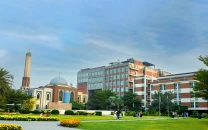The art of war
Brigadier (retd) Javed Hussain warns top brass that unless it gets its tactics right, its strategy is bound to fail.

Brigadier (retd) Javed Hussain, a veteran of the Special Services Group and the armoured corp, warns the top brass that unless it gets its tactics right, its strategy is bound to fail.
In your experience, how much planning would have gone into the attack on the PNS Mehran?
Any attack is basically a battle between the attackers’ plan and the defenders’ plan. Before any operation, there has to be adequate intelligence to infiltrate the base and destroy assigned targets. That can only be done if the team has adequate information about that area. Now PNS Mehran is a vulnerable area (VA), and inside it are vulnerable points (VPs) like the hangars in which the Orion aircraft are parked, and the hangars where the helicopters were parked, along with other aircraft. The other VP is the PAF airstrip where the C-130s were parked. The planner would need to know everything about the base, including the perimeter defence (number of searchlights etc), and the number of perimeter defenders. Second, they need to know the internal defence of the base and third, whether the targets are actually in the base at the time of the attack. All this requires updated real-time intelligence. The attackers cannot overwhelm the defenders unless they know all there is to know about the defenders. If you know your enemy you will win.
Given what we saw in this attack, do you think the attackers were on a suicide mission, or was this a conventional guerrilla/commando raid?
They accomplished their primary mission within 2 hours. At that point they could have gotten away, but I believe they were under an oath to fight to the death, as in a classic fedayeen mission.
When people say there were only four or five attackers, I think they are correct. Had there been more, they would have divided into two teams, with one team going for the Orions while the second team waited. Once the Orions were destroyed, the second team would rush in, destroy the C-130s and exfiltrate, but since they were four, they went straight for the Orions, which were clearly their primary targets. They then opted to fight to the death, marking this clearly as a fedayeen mission. A regular special operations (spec ops) team would rarely be assigned suicide missions. It’s another thing if they get cornered and have to fight till the last, but a fedayeen mission being assigned to regular special forces is rare, if not entirely unheard of.
Given what we saw, were these attackers trained to a level that they could take on the SSG?
Training-wise they were at least as good, and they were assisted greatly by the sheer lack of security. The real test would have been if the security had been up to par, but they were certainly superior to the defenders in training, skill, and most of all, motivation. A valiant officer like Yasser Abbas of the rapid reaction force charged into battle, but how many others would have?
Apparently, the defenders were not trained in these contingencies and thus they were ambushed and pinned down by the enemy. The attackers were waiting when the Naval commandoes came and managed to kill some of them as well. Even less well trained attackers would have succeeded, as they were not up against commandoes initially, but base defenders. That’s why commando ops most often succeed — because of the mismatch between skills.
Would it be possible to know the layout and capabilities of the base so well without inside information?
That cannot be ruled out, because from experience I know that there are soldiers who, when they go back to their villages, come under the influence of the village mullahs’ sermons, and are then motivated to help the Jihadis. This kind of thinking now exists in the rank and file in all three services. They are ripe for recruitment, and the Jihadis know this.
Is it even possible to purge the ranks of people with a pro-Jihadi mindset?
There has to be a major campaign launched by all the commanders, starting from the top, with directives issued all the way down the line. The corps commanders, company commanders, brigade commanders etc must be on board and willing to acknowledge and deal with the problem. Here is where the intelligence agencies will play a crucial role. The way it has to be done is that intelligence officials join as fresh recruits and attempt to penetrate the networks. Then they can identify who the Jihadi elements or sympathetic elements are so they can be dealt with, or even lead to the ringleaders.
We have seen repeated cases highlighting the problem of radicalisation in the armed forces, why hasn’t such a purge been carried out?
The top brass seems to simply refuse to accept the reality that the military is faced with a serious internal threat. They think these people are an exception and a small exception at best. They are wrong.
In conversations with serving military officials, and looking at some of the rhetoric in the right wing press and from right wing commentators, fingers are being pointed at India etc, but if as you say this was a one-way fedayeen mission, does that not point towards jihadi elements?
There is no doubt that hostile intelligence agencies are operating in Pakistan, but what’s being overlooked by everyone is that we’re all talking too big. We talk of policies and strategies, instead of effective tactics and implementation. In the Mehran base attack the buck ultimately stops at the Naval chief, but the man on the spot was the commander of the base. High policy and strategy is no concern of his. He knows that his country is in a state of war with an internal enemy and therefore he is not concerned by whether his base is threatened by RAW, the CIA or Jihadis. His concern must be to secure the base. In order to do that he has to develop an effective security plan. Unfortunately as far as I know, that was simply not done.
How would it be done?
After the 1965 war, the air force chief Nur Khan decided to strengthen security at all air bases and asked the SSG to test the base security. We carried out separate operations against bases in Sargodha, Badin, Peshawar, Mauripur base the PAF Faisal base.
We penetrated Sargodha thrice, and each times we employed new tactics. Once we paradropped in the vicinity of the base, went through the main gate in air force uniforms and commandeered air force vehicles that were coming towards the gate after removing the drivers. The security was so lax that they let us in after only seeing our uniforms. We already knew where all the VAs were, from the fuel dumps to hangars to even the pilots’ restrooms, so we went straight for our targets. The air force learned a lot from these exercises.
The Mehran base commander, should have done the same, knowing that he was faced with a ruthless, highly trained, highly motivated enemy — far more motivated in fact than your own troops, because how many of those would undertake a fedayeen mission? You have to consider all the possibilities, then plan and resource your plans. Here the attackers’ plan succeeded and the defenders’ failed. It doesn’t matter if the handlers are in Waziristan, New Delhi, Tel Aviv or Washington, what matters is winning the battle between the minds of the attacking elements and the defending elements.
Given the state of the Mehran base, how vulnerable are our other bases to similar attacks?
In the GHQ attack, they were defeated apparently by tribals from Waziristan, and it can happen again. The Chaklala base is also vulnerable. The way it works — and this was probably the case with Mehran — is that they have a number of people deployed for security, and they feel secure because they have 50 people at the gate. But what is the caliber of those people? Are they physically and mentally fit? If they are not — and in 99 per cent of cases they are not — then there is a problem, causing a total mismatch which means the attackers will always win. We have seen over 100 attacks on military and LEA installations in the past 7 years and each time the attackers have succeeded. They have to employ the thieves to make these places thief-proof. These people need to pause and think small. Strategy must come later because in the face of tactics, strategy submits.
When it is clear that the military is a major target, why haven’t these issues been addressed?
Just read the statement made by the Naval chief that there was no security lapse and that the attackers were well trained and equipped with ‘sophisticated’ weapons… like AK-47s, hand grenades and wire-cutters! These are the kind of minds we have directing this war. In the GHQ attack, the Military Intelligence directorate itself was occupied by the terrorists, but in a clear miscalculation, they decided not to blow up the building and instead use the hostages as bargaining tools. That gave the SSG time to go in and take them out. It’s not that the militants are so strong or skilled but that our own adaptive capabilities are weak.
How many of these failures are due to an unwillingness to coordinate and due to turf wars between the agencies?
In Mehran, there were were two groups of VPs in the base: the air force and the navy. The attackers entered from the air force side and went straight for the Naval VPs, so where was the air force? There was no coordination even within the base! We have countless agencies, but we need a body to coordinate their activities. For example, special branch warned GHQ of a possible attack six months before the strike, but they were ignored and written off as alarmists. A controlling and coordinating body needs to be set up under someone who must get daily reports, even if it’s an NTR (nothing to report), because if something happens he must be held accountable. The ISI itself should have suggested it, but the ISI thinks it is the mother of all agencies, and it doesn’t need a father.
MAPS FOR LOST TERRORISTS
Google Earth isn’t just used to navigate an unfamiliar part of the city — since at least 2007 there have been concerns about the use of its detailed imagery by terrorists.
In 2005, officials at the Australian Nuclear Science and Technology Organisation called on the company to censor images of the plant, warning that they could be used by terrorists.
According to Wikileaks, since 2006, the Chinese government has been urging the US to “take action to get Google to reduce the resolution of the Google Earth images of China’s military, nuclear, space, energy and other sensitive government agency installations in order to deprive terrorists of potentially dangerous information”. It was also concerned about the ability of users to freely annotate specific locations on Google Earth imagery, which would provide information about important Chinese agencies and sensitive installations.
In late 2005, after seeing its bases on Google Earth, the Thai military wanted Google to censor not just important state buildings but also tourist attractions. Similarly, Mosnews reported that Russian generals raised the alarm over Google Earth in 2005, saying “terrorists will see all that they need to carry out an attack in any part of the world.” Security fears were also raised in South Korea where the Ministry of Defence said, “The satellite photos of Cheong Wa Dae and military bases released on the website ‘Google Earth’ might violate domestic security laws.”
In 2007, Khaled Jaabari of Palestine’s al-Aqsa Martyrs Brigade, admitted that the group was checking its own maps against Google Earth to identify vulnerabilities for rocket strikes in Israel. In early 2007, Google Earth images of British bases were found in the homes of insurgents in Iraq, with longitude and latitude coordinates written on the back. Reports that insurgents were buying CDs of Google Earth imagery in the markets of Basra, so as to better target their RPGs inside UK bases prompted pressure from the US and UK military. Subsequently, the most up-to-date Digital Globe imagery from Iraq was removed from Google Earth. Since 2007, there have been no new imagery updates for Iraq and Afghanistan in Google Earth.
India’s President Abdul Kalam was one of the first to express concern over pictures of sensitive locations on Google Earth. After the Mumbai attack, police claimed that terrorists familiarised themselves with the target using satellite images with reports that Faheem Ahmed Ansari, a suspected militant, said he was shown maps of Indian locations on Google Earth by members of Lashkar-e-Taiba.
Published in The Express Tribune, Sunday Magazine, June 5th, 2011.



















COMMENTS
Comments are moderated and generally will be posted if they are on-topic and not abusive.
For more information, please see our Comments FAQ